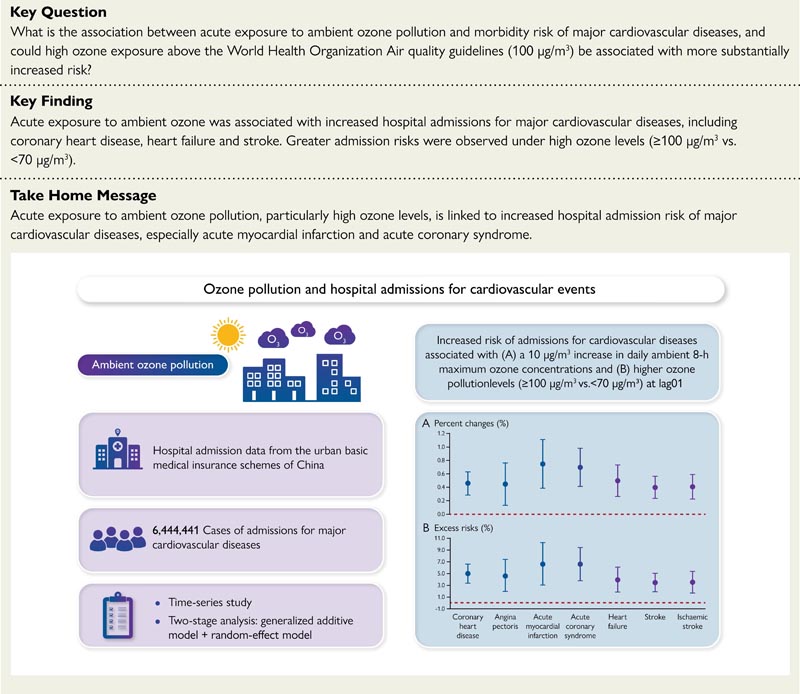
The first evidence that exceeding the World Health Organization (WHO) ozone limit is associated with substantial increases in hospital admissions for heart attack, heart failure and stroke is published today in European Heart Journal , a journal of the European Society of Cardiology (ESC). Even ozone levels below the WHO maximum were linked to worse health.
"During this three-year study, ozone was responsible for an increasing proportion of cardiovascular disease admissions as time progressed," said study author Professor Shaowei Wu of Xi’an Jiaotong University, China. . “Climate change, by creating atmospheric conditions that favor the formation of ozone, is believed to continue to increase concentrations in many parts of the world. Our results indicate that older people are particularly vulnerable to the adverse cardiovascular effects of ozone, meaning that worsening ozone pollution with climate change and the rapid aging of the world’s population may lead to even higher risks of cardiovascular diseases in the future".
Ozone is a gas and the main air pollutant in photochemical smog. Ozone pollution is different from the ozone layer, which absorbs most of the sun’s ultraviolet radiation. Ozone pollution is formed when other pollutants react in the presence of sunlight. These other pollutants are volatile organic compounds and nitrogen oxides emitted by motor vehicles, power plants, industrial boilers, refineries, chemical plants, and facilities that burn biomass and fossil fuels. Previous studies have suggested that ozone pollution damages the heart and blood vessels, but there is limited and inconclusive evidence on its influence on the risk of cardiovascular disease.
This study examined the association between environmental ozone pollution and hospital admissions for cardiovascular diseases. Data on daily hospital admissions for cardiovascular diseases during 2015 to 2017 in 70 cities in China were collected from the two major national health insurance systems. During the study period, the two databases covered approximately 258 million people in the 70 cities, equivalent to more than 18% of China’s population. Types of cardiovascular diseases included coronary heart disease, stroke, and heart failure, as well as subtypes such as angina, acute myocardial infarction, acute coronary syndrome, ischemic stroke, and hemorrhagic stroke.
The eight-hour maximum daily average concentrations of ozone, fine particulate matter (PM2.5), inhalable particulate matter (PM10), sulfur dioxide, nitrogen dioxide, and carbon monoxide were obtained for each city from the National Real-Time Publishing Platform. of China’s Urban Air Quality.
During the study period, there were 6,444,441 hospital admissions for cardiovascular diseases in the 70 cities and the eight-hour average daily maximum ozone concentration was 79.2 μg/m3. Exposure to ambient ozone was associated with increased hospital admissions for all cardiovascular diseases studied except hemorrhagic stroke, independently of other air pollutants. For example, each 10 μg/m3 increase in the two-day average of eight-hour maximum ozone concentration was associated with a 0.40% increase in hospital admissions for stroke and a 0.75% increase for heart attack. acute myocardium.
Professor Wu said: "Although these increases appear modest, it should be noted that ozone levels can rise to more than 200 μg/m3 in the summer, and these increases in hospitalizations would be amplified by more than 20 times at more 8% due to stroke and 15% due to acute myocardial infarction.”
The researchers also estimated the excess risk of cardiovascular disease admission associated with ozone concentrations at or above the WHO air quality guideline (100 µg/m3) compared with levels below 70 µg/m3. Ozone levels below 70 μg/m3 mostly occur naturally and are not due to human activity. Compared with two-day eight-hour average peak concentrations below 70 μg/m3, levels of 100 μg/m3 or higher were associated with substantial increases in hospital admissions for cardiovascular disease, ranging from 3.38 % for stroke to 6.52% for acute myocardial infarction. However, lower concentrations of 70 to 99 µg/m3 (vs. less than 70 µg/m3) were also associated with increases in hospital admissions, ranging from 2.26% for heart failure to 3.21 % due to coronary heart disease.
During 2015 to 2017, 3.42%, 3.74%, and 3.02% of hospitalizations for coronary heart disease, heart failure, and stroke, respectively, were attributable to ozone pollution. When each year was analyzed separately, the proportions increased over time. For coronary heart disease, ozone was responsible for 109,400 of 3,194,577 admissions over three years. Professor Wu said: “This suggests that 109,400 admissions for coronary heart disease could have been avoided if ozone concentrations were 0 µg/m3. This may be impossible to achieve given the presence of ozone from natural sources. "However, we can conclude that a considerable number of hospital admissions for cardiovascular disease could be avoided if levels were below 100 μg/m3, with further reductions at lower concentrations."
In an accompanying editorial, Professor Thomas Münzel and co-authors said: "Projections for Europe suggest that ozone will play a more dominant role as a health risk factor in the future due to climate change with rising temperatures and, consequently, to increased photochemical ozone formation. The strong link between climate change and air quality means that long-term emissions reductions to address global warming will play a key role in alleviating pollution. by ozone and improving the air we breathe.”
Conclusion Ambient ozone was associated with an increased risk of hospital admission for cardiovascular events. Higher risks of admission due to cardiovascular events were observed on days of high ozone pollution. These results provide evidence of the harmful cardiovascular effects of ambient ozone and require special attention in the control of high ozone pollution. |
















